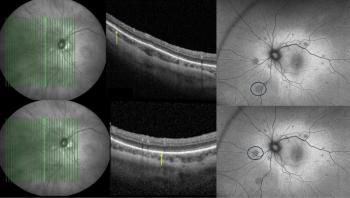
Update and clinical pearls from the Advanced Glaucoma Intervention Study
The Advanced Glaucoma Intervention Study (AGIS), which began 20 years ago, was a landmark trial that produced important findings on surgical interventions and the role of IOP in progression.
The Advanced Glaucoma Intervention Study (AGIS), which began 20 years ago, was a landmark trial that produced important findings on surgical interventions and the role of IOP in progression.
AGIS was designed to evaluate management options when medications fail to control high-pressure glaucoma and test the hypothesis that initiating surgical treatment with argon laser trabeculoplasty (ALT), which then was a relatively new procedure, was more effective than starting with trabeculectomy, said Douglas E. Gaasterland, MD, who provided an update and clinical pearls from AGIS during a glaucoma subspecialty day presentation at the American Academy of Ophthalmology annual meeting. He is clinical professor of ophthalmology at George Washington University School of Medicine and Georgetown University School of Medicine.The two main outcomes were visual field and visual acuity.
"We felt that if we were going to compare these, we should pay attention to what counts to a patient, and that is visual function," said Dr. Gaasterland, who was co-chairman of the AGIS Study Group.
AGIS was sponsored by the National Eye Institute and the Office of Research on Minority Health, National Institutes of Health. Between April 1, 1988, and Nov. 30, 1992, 591 patients were enrolled at 12 centers in the United States. Either one eye or both eyes needed surgery for elevated IOP after failure of medical treatment for open-angle glaucoma. About one-third of the patients had both eyes eligible simultaneously, for a total of 789 enrolled eyes. Of the patients, 249 (42%) were self-identified as white, 332 (56%) as black, and 10 (2%) as other.
Study design
The study design was to assign patients randomly to either ALT or trabeculectomy, but because the investigators realized that some interventions would fail, patients were assigned to sequences of interventions. They were referred to as ATT (ALT followed by two courses of trabeculectomy) and TAT (trabeculectomy, ALT, trabeculectomy). For patients with both eyes eligible, the more damaged eye was randomly assigned to one of the sequences, and the other sequence was assigned to the other eye.
Subsequent surgical interventions were begun on the failure of the previous intervention, as defined in the AGIS protocol. Supplemental medications were prescribed as needed.
Follow-up ended on March 31, 2001. The duration of participation at that point ranged from 8.5 to 13 years. There were 422 living patients at the end of follow-up, and 328 (78%) remained active.
Race, vision loss
The study resulted in several important findings, and one of the most significant was an unexpected interaction between race and substantial long-term visual function loss by 10 years, Dr. Gaasterland said.
"In patients self-identified as black, fewer eyes in the ATT sequence lost visual acuity than eyes in the opposite sequence. By 10 years, the visual field was about the same. By contrast, for white patients the TAT sequence proved better; fewer eyes in TAT lost visual field than eyes in the ATT sequence. After 5 years, visual acuity was about the same in the two groups," he said.
In the black patients, many more had loss of visual acuity throughout follow-up. White patients initially did better with the ATT sequence, but over time the visual acuities converged.
Visual field loss in black patients was similar in both treatment sequences, whereas in white patients the trends for the two groups diverged over time, and it was protective to be in the TAT sequence.
IOP and visual field loss
The second widely disseminated key result showed a relationship between IOP and visual field loss. Patients were categorized by their average IOP during the follow-up; subgroups were IOP over 18 mmHg 100% of the time, 75% to 99% of the time, 50% to 74%, or less than 50%. A higher average IOP during follow-up was associated with a greater likelihood of visual field worsening, a finding sometimes referred to as the "IOP dose-response curve," Dr. Gaasterland said.
"There's good news from AGIS," he continued. "About 66% of patients with advanced glaucoma, as defined by medication failure, do well. This is a challenge to those developing new techniques for intervention when medications fail. The bad news, though, is that about one-third of the eyes lose important amounts of visual function during 10 years of follow-up. A few baseline risk factors exist, and a low IOP helps during follow-up, but not completely. This is a challenge to researchers in neuroprotection. We really need more help."
The baseline risk factors for subsequent visual function loss identified in AGIS were having better visual field or worse visual acuity at baseline. Having better visual acuity at baseline increased the risk of future visual acuity loss.
Several race-dependent differences in findings also emerged from AGIS. At enrollment and through follow-up, black patients were prescribed more medications in both treatment sequences than white patients. ALT was less likely to fail black patients and trabeculectomy was more likely to fail them. In the TAT sequence, black patients had a greater likelihood of having IOP >18 mmHg.
Investigators also observed trends related to cataract formation. After adjustments were made for age and diabetes, it was found that trabeculectomy increased the risk of cataract formation by 78% compared with ALT. ALT before trabeculectomy did not increase the risk of cataract after trabeculectomy, however.
In addition, visual field and visual acuity improved after cataract surgery, and the amount of improvement in both was greater in white than in black patients. Visual field improvement was related to race and was greater for eyes with lower presurgical acuity.
The study also identified risk factors for surgical failure. Younger age and higher IOP at enrollment and preintervention increased the risk of failure of both ALT and trabeculectomy. Postoperative IOP elevation and marked inflammation increased the risk of trabeculectomy failure.
Newsletter
Get the essential updates shaping the future of pharma manufacturing and compliance—subscribe today to Pharmaceutical Technology and never miss a breakthrough.













































